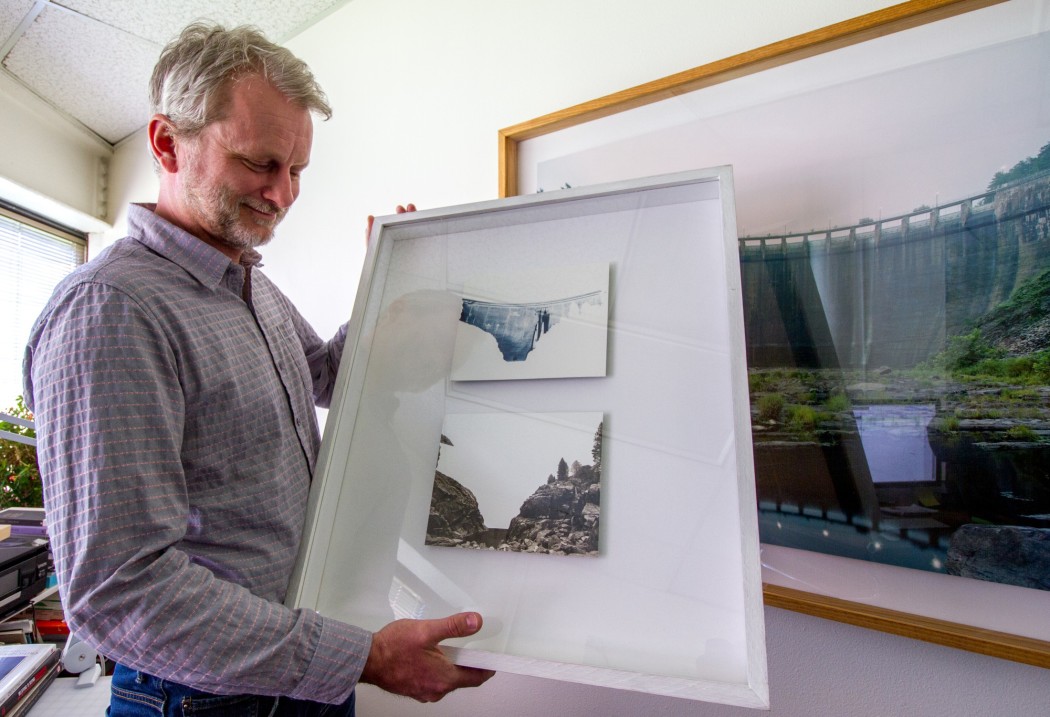USU photography professor releases dam photos
Carsten Meier is probably the best dam photographer in Logan. And now, with his second book, he’s making it known.
Meier, who is an associate professor of photography at Utah State University, recently published his book, “Dam,” through Kerber publishers.
“It is supposed to assist us in our understanding of how we deal with our natural environment,” Meier said. “That is sort of the ultimate goal of this book.”
The book features portraits of dams in Europe and the United States, taken over the past five years.
“The impetus was to create a survey of public interest to photograph dams and create a photographic typology,” Meier said. “The dam is sort of like an iconographic symbol of our relationship to the environment.”
Though Meier takes a neutral stance on dam activism, much of his inspiration for the project comes from the history of dams and environmental activism in the U.S.
“I’m not necessarily interested in forming a political statement with this,” Meier said. “Though the last images show two dams that have been taken out.”
Meier said he hopes to portray how dams reflect our relationship to water and the environment through his photography.
“I hope it builds an understanding of our impact on the environment, and helps consider all options,” he said.
Meier’s inspiration for the project began in 2010 after he read “Wilderness and the American Mind” by Roderick Nash. He was also inspired by the Sierra Club, which was helped in its fight for environmental protection by the photography of Ansel Adams in national parks.
“What photography is capable of is presenting a virtual reality of multiple ideas at the same time which you can’t even have in person,” Meier said. “I think that in particular will allow us to sort of comprehend that subject of the dam and landscape more than if I just go to one.”
Meier said some people view dams as an essential piece of human development, but others see dams as an obstacle in the landscape that needs to be gone.
Jack Schmidt, a USU professor of geomorphology and river management who contributed some of the only text in the book, said he focused on presenting both sides of the dam issue in his writing.
“Dams are the renewable energy everybody loves to hate,” Schmidt said.
Schmidt said the pros and cons of dams are many and often hotly debated. His article takes a neutral stance focusing solely on the pros and cons of dams. Among the tradeoffs Schmidt lists are hydroelectricity vs. blocked fish migration, flood control vs. interrupted natural habitat, and recreation vs. trapped sediment.
Schmidt said removing every dam in the world is not possible, nor necessarily desirable, but there are good alternatives.
“One of the unavoidable impacts of water storage in reservoirs is evaporation on that surface of water,” Schmidt said. “The alternative that we do now and that we will do more of is underground storage of water. That’s been practiced for a decade or two and is an active program.”
Schmidt said the power from dams is essential for the energy spikes in daily American life.
“What we do today is use coal-fired and nuclear plants to provide the baseload that society needs 24/7,” he said. “And then when we all wake up and need more electricity, those blips are when we need hydropeaking.”
The final lines of Schmidt’s text in the book states, “Dams capture all of the complexities of human society.”
Meier said he approached the photography with specific purpose to represent the dams and their relationship to the environment.
“In most cases I was able to choose the central perspective,” he said.
Meier took the portraits at moments of transitional light in order to get a neutral lighting.
“I took most of these pictures right after sunset or right before sunrise,” he said. “I needed that neutral light.”
Both Meier and Schmidt agreed one of the most controversial dams in U.S. history is the Glen Canyon dam.
“The water level rises during the day because they turn on the turbines,” Meier said. “And at night the water level goes down.”
In the Glen Canyon Dam, there are two feet of fluctuation, which doesn’t allow the insects to populate.
“And that’s the reason why that particular section is dead,” Meier said. “The silt that comes from the tributaries into the dam, stays in the dam. And that silt is necessary for growth in lakes and reservoirs like lake Powell.”
USU receives all of its power from the Glen Canyon dam.
Meier said most of all, he wants to help contribute to a shift he has seen in the way we perceive nature.
“We used to have this idea that we are improving nature,” Meier said. “This idea that wilderness is something fearsome is going away. What we have discovered today is we are a part of nature and we need nature.”
—mikeburnham3@gmail.com


Nice article, helped me a lot. I know that Photography is a new opportunity to make a successful career. Actually we can easily learn Photography if we get the right support or guide. I was searching online and came upon a video. This video opened my eyes!!! The video will show you how to learn photography in as little as time!! A lot of people already learn photography after watching this video. Watch now free video hope it will help those who really want to learn photography Watch free